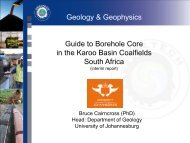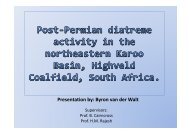coaltech upper olifants river catchment wetland inventory ...
coaltech upper olifants river catchment wetland inventory ...
coaltech upper olifants river catchment wetland inventory ...
Create successful ePaper yourself
Turn your PDF publications into a flip-book with our unique Google optimized e-Paper software.
3.9 Common <strong>wetland</strong> types in UORC<br />
According to Palmer et al (2002) the most extensive <strong>wetland</strong> type in the <strong>catchment</strong> are the<br />
riparian <strong>wetland</strong>s. Since riparian <strong>wetland</strong>s are associated with <strong>river</strong>s and streams, the total<br />
length of the <strong>river</strong>s in the <strong>catchment</strong> is the most important contributing factor towards making<br />
the riparian <strong>wetland</strong>s the most extensive <strong>wetland</strong> type (22%).<br />
The seasonally inundated channelled valley bottom floodplains with footslope seepage<br />
<strong>wetland</strong>s are the <strong>wetland</strong> types with the largest individual <strong>wetland</strong>s (Palmer et al 2002).<br />
Although <strong>wetland</strong>s in this type are few, they account for 18% of the <strong>wetland</strong> area indicated in<br />
Palmer et al (2002).<br />
Numerous pans occur in the study area, but account for only a small percentage of the total<br />
<strong>wetland</strong> area (5%). The non-permanent pans are more numerous than the permanent pans,<br />
but account for a smaller total area (less than 4%). The permanent pans in the UORC are<br />
larger than the non-permanent pans (Palmer et al 2002).<br />
Artificial <strong>wetland</strong>s (dams and weirs) are the most common <strong>wetland</strong>s in the study area,<br />
accounting for almost 50% of the <strong>wetland</strong>s recorded in Palmer et al (2002). Some of the<br />
dams and weirs are small and the total area therefore, account for 11% of the total <strong>wetland</strong><br />
area.<br />
3.10 Status of <strong>wetland</strong>s within the UORC<br />
Various <strong>wetland</strong> assessments were conducted on the <strong>wetland</strong>s in the UORC for<br />
developments, mining expansions etc. The results from some of these assessments are<br />
included below to give a general indication of the status of the <strong>wetland</strong>s in the UORC. A map<br />
(Figure 7) is included to indicate the location of the <strong>wetland</strong>s discussed in relation to the<br />
<strong>catchment</strong>.<br />
Wetland Database for UORC - 63 -




